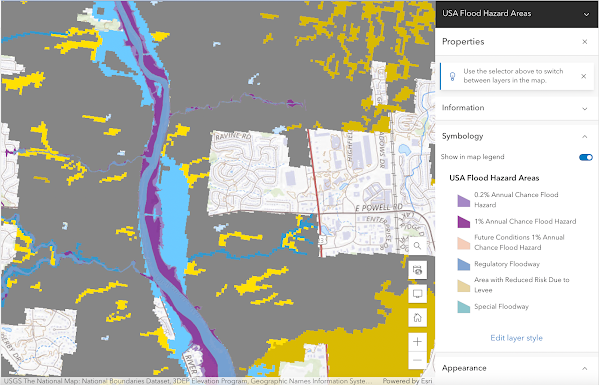Watershed Characteristics
Some of the major characteristics of the Olentangy River Watershed include:
Flowing through downtown Columbus, Ohio

Geology:
- Three geological regions
- Upper, middle, and lower
- Much of the geology of the watershed is influenced by glaciers that used to mover through the area
- The entire upper region is now agricultural area
- The middle region consists of limestone bed rock, a flood plane in the western part of the river and has a pretty consistent width of 40-50 feet
- The lower region is where the confluence to the Scioto river is located, it is also broader and deeper and has been back filled with silty alluvium and glacial outwash.
Land-use:
- Agricultural
- Deciduous forest
- Evergreen forest
- Mixed forest
- Pasture
- Rangeland
- Commerical
- High density residential
- Low density residential
- Forested wetland
- Emergent wetland
Aquatic Life:
Some of the most important organisms that call this watershed home are the benthic invertebrates. The are important in determining the quality of water and can also help determine whether or not an area of the river is compromised. Along with the macro invertebrates there are many other aquatic species that call this watershed home, such as:
- Fish:
- Spotfish Shiner
- Golden Redhorse
- Smallmouth Bass
- Blunt Nose Minnow
- Bluegill
- Common Carp
- Quillback Carp Sucker
- Endangered, threatened, or invasive fish:
- Northern Brook Lamprey
- Spotter darter
- Blue Breast Darter
- River Redhorse
It is of interest that all of these species occur in the heavily urbanized stretch of the river between I-270 and the confluence with the Scioto River in Franklin County as well as in more pristine stretches of the Olentangy River paralleling High Banks Metro Park (MORPC. 1997; ODNR Natural Heritage database, 2001).
- Freshwater Mussels (at least 14 species call the watershed home)
- Two state special interest species are found here, which include the Round Pigtoe and the Wavy-lined Lampshell
- State endangered: Snuffbox and Round Hickory Nut
- Three-ridge shell
- White Heel Splitter
- Plain Pocketbook
- Fat Mucket
- Elk Toe
- Fluted Shell
- Kidney Shell
Water Quality:
- Agriculture run-off plays a major role in water quality in the watershed
- Mean dissolved oxygen (DO) levels are above 6 mg/L
- Fecal and E. coli levels vary drastically along different mile marks along the watershed
- Fecal Coliform's ranged from less than 100 MPN near Horseshoe run to over 800 MPN near Turkey run.
- E. coli counts were in similar range from less than 100 MPN to over 400 MPM
- Nutrient levels also varied:
- Ammonia-N: ranged from .4 mg/L to .1 mg/L
- Nitrate-Nitrite-N: less than 1 mg/L to about 4 mg/L
- Phosphorus: varied from .1 mg/L to .5 mg/L
- Heavy metals and chemical found in sediment along the watershed included:
- Polycyclic Aromatic Hydrocarbons
- DDT
- Polychlorinated Biphenyls (PCBs)
- Cadmium
- Chromium
- Lead


Comments
Post a Comment